Top 12 AI Tools for Content Creators in 2025
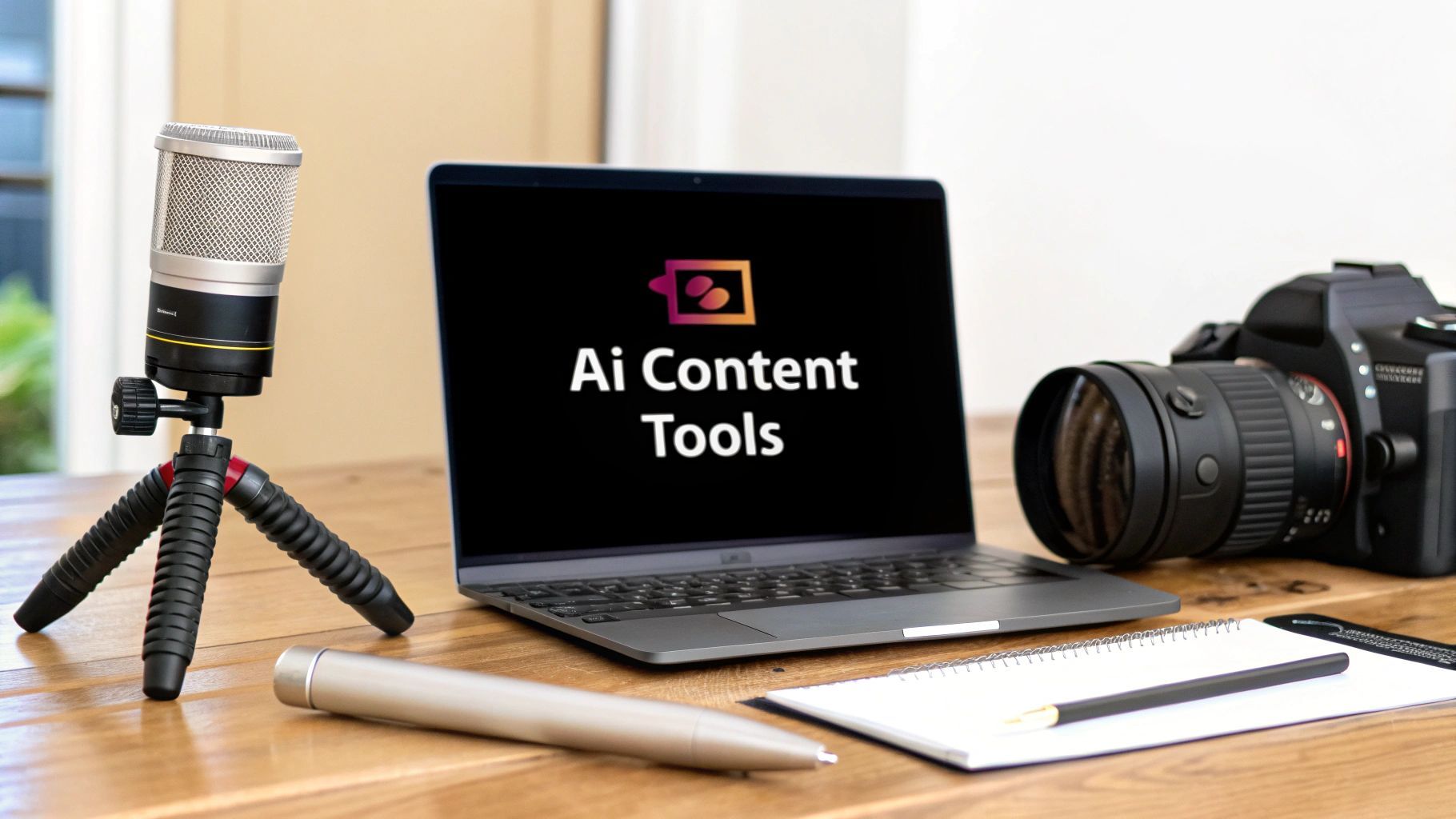


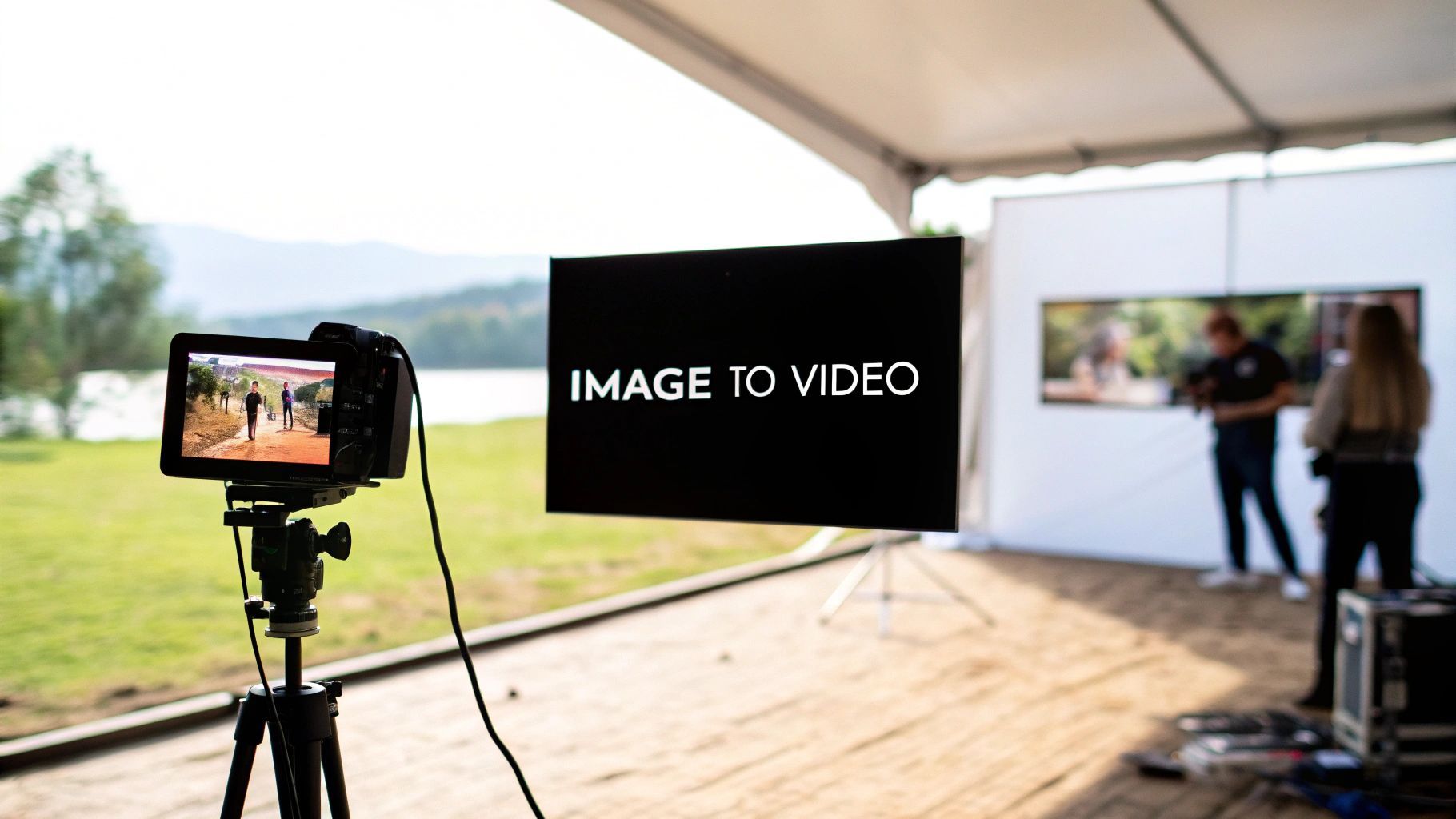
Learn how an AI image to video generator can bring your photos to life. Discover top tools and tips to create engaging videos effortlessly.
Alright, let's stop talking like robots and start talking about something genuinely cool: turning your still photos into living, breathing videos.
An AI image-to-video generator is essentially a magic wand for your pictures. You give it a static photo, and it uses artificial intelligence to create a short, animated video clip from it. Imagine a digital animator who can instantly look at your photo and figure out how to add a little life—the subtle sway of trees, the shimmer of water, or even a dramatic camera zoom.

So, you've got a killer photo. What if it could do more than just sit there? What if it could move, tell a story, and grab everyone's attention? That’s exactly what we're talking about. These tools give anyone, and I mean anyone, the power to make dynamic video content from a single image. No film school required.
Think of a stunning landscape shot you took. An AI can look at that photo and instantly animate the clouds drifting across the sky or the gentle ripples on a lake. It can even take a portrait and add a subtle, lifelike blink. It's not just a gimmick; it's about adding a spark of life where there was none before.
This isn't just a cheap trick like stretching your photo into a weird, wobbly mess. A proper AI image-to-video generator actually understands your picture. It identifies the different elements—a person, the sky, water—and then predicts how those things would realistically move. It then intelligently generates brand-new pixels to build a smooth, believable video sequence.
Forget needing a Hollywood budget or complex animation software. The real magic here is giving everyone the power to create eye-catching video content.
This technology isn't just a fun toy; it's a huge deal for content creation. The demand for engaging video is through the roof, which is why the AI video generation market is exploding. In fact, this corner of the tech world, which includes image-to-video tools, is expected to be worth around $2 billion by 2025. It's also projected to grow at an incredible 25% each year through 2033. If you want to dive deeper into the numbers, you can find more market data on Data-Insights Market.
So, why should you care? Because this technology offers some seriously practical advantages that can give your content an immediate boost.
Let's break down the transformative advantages that AI image to video generators bring to the table for creators and businesses alike.
| Benefit | Impact on Your Workflow |
|---|---|
| Effortless Engagement | Moving images are like magnets for eyeballs on a busy social feed. A little motion can make someone stop scrolling. |
| Budget-Friendly | Skip the insane costs and steep learning curves of traditional video production and animation software. |
| Creative Freedom | Easily experiment with different animation styles to add emotion, drama, or a bit of fun to your photos. |
| Speed and Simplicity | Turn a static image into a dynamic video in minutes, not days. It's a massive time-saver. |
In short, these tools give you a powerful new way to tell stories and connect with your audience, all without breaking the bank or spending weeks learning a new skill.
With a tool like SendFame, you can give your content that professional edge in just a couple of clicks. This guide will pull back the curtain on this incredible technology, showing you how it's shaking up the content world and how you can make your own photos the star of the show.
So, what's really going on under the hood when you turn a static photo into a moving video? It’s not just some cheap party trick where pixels get stretched and warped. It's more like teaching a robot to dream, using your picture as the starting point for that dream.
Think of the AI as a seasoned artist who has spent a lifetime studying millions of videos. It’s absorbed the subtle physics of how a flag ripples in the wind, how clouds drift across the sky, and how light dances on water. When you give it your photo, it taps into that vast knowledge to make an educated guess—a digital prophecy, if you will—about what happened just before or just after you clicked the shutter.
To pull this off, the AI relies on a one-two punch of clever techniques.
First, it needs spatial awareness. This is the AI's knack for looking at your flat, 2D picture and understanding it as a 3D space. It figures out what’s what: the sky is way back there, that tree is closer, and the person standing front and center is probably the star of the show. It’s building a mental map of your scene.
Then comes the fun part: motion interpolation. Once the AI has its map, it starts filling in the blanks. It essentially asks, "Given what I see, what's the most likely way things would move?" If there are clouds, it animates them drifting. If there's a lake, it adds gentle ripples. It's not random; it’s a calculated, artistic guess that creates the frames between the still moment you captured.
This little infographic gives you a bird's-eye view of how a simple image gets this dynamic treatment.
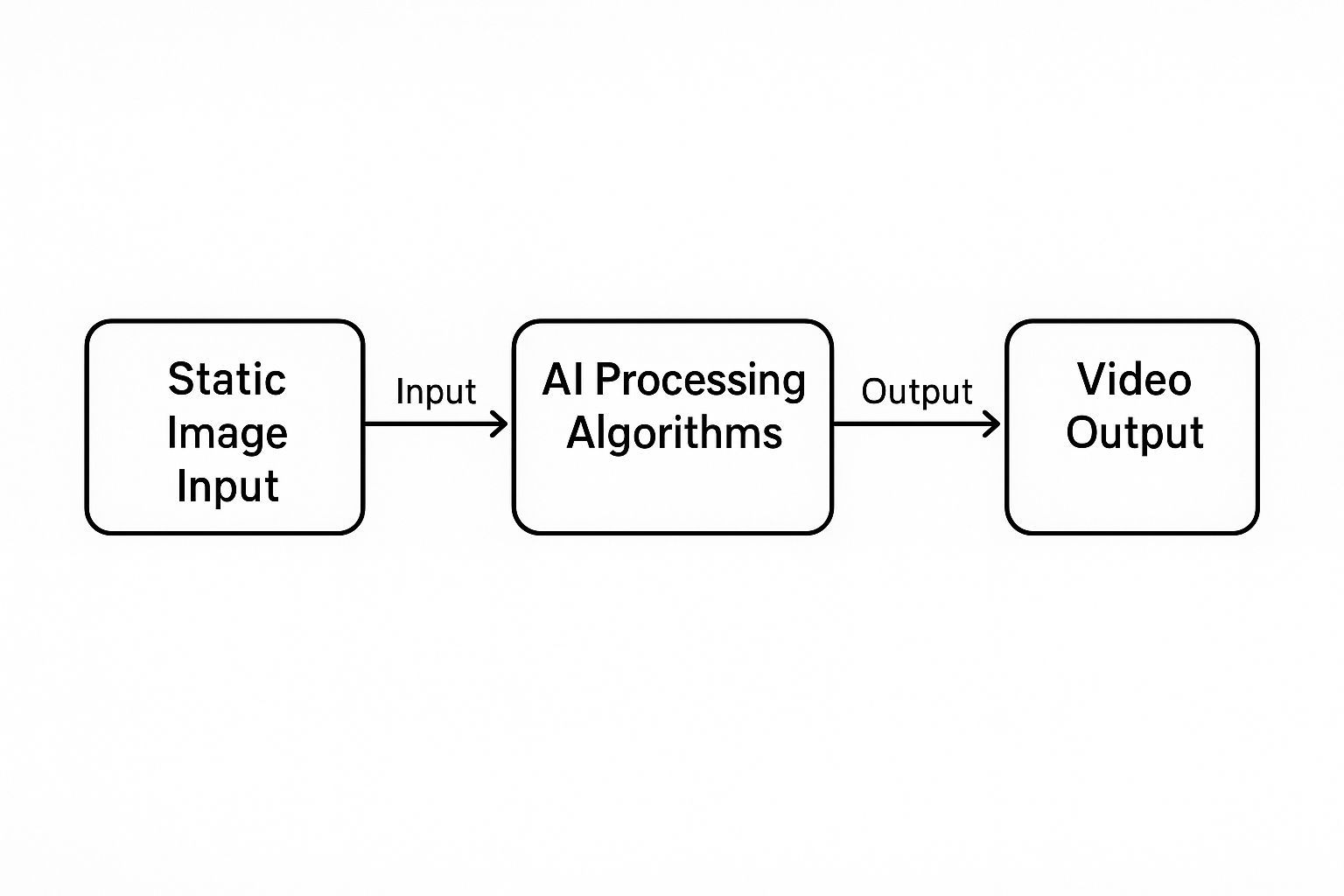
As you can see, the AI is like a sophisticated production engine. You feed it a simple image, it runs it through some mind-bending processes, and out pops a completely new, animated creation.
So how did the AI get so good at this? The magic comes from a couple of seriously advanced models, which you can think of as two rival artists with very different creative processes.
Generative Adversarial Networks (GANs): Picture two AIs in an endless art battle. One, the "Generator," paints new video frames. The other, the "Discriminator," is a harsh critic trained on real-life videos. Its only job is to call out the Generator's work as "fake!" This constant feedback loop pushes the Generator to create animations that are incredibly realistic and fluid, just to fool its rival. Diffusion Models: This method is more like a sculptor patiently chipping away at a block of marble. The AI starts with a cloud of digital noise—think TV static—and gradually refines it, step by step, dialing down the chaos until a clear, coherent video sequence emerges. It’s a beautifully meticulous process of revealing motion from randomness.
At its heart, this technology is all about prediction. The AI isn't just wiggling pixels around. It’s making a highly educated guess about how the world in your photo would behave, all based on that library of visual knowledge it has studied.
These models are the same powerhouses that fueled the recent explosion in AI image generation. Now, that same genius for creating photorealistic stills is being applied to generate entire video sequences, frame by mind-blowing frame.
The principles here are fascinatingly versatile. Take a look at how AI powers Speech to Text Software for a great parallel. In both scenarios, the AI is taking one kind of data—pixels or sound waves—deconstructing it, and then rebuilding it into something totally new and useful based on learned patterns. It’s a powerful reminder that whether it’s turning a picture into a video or your voice into text, it all comes down to teaching a machine to understand our world.
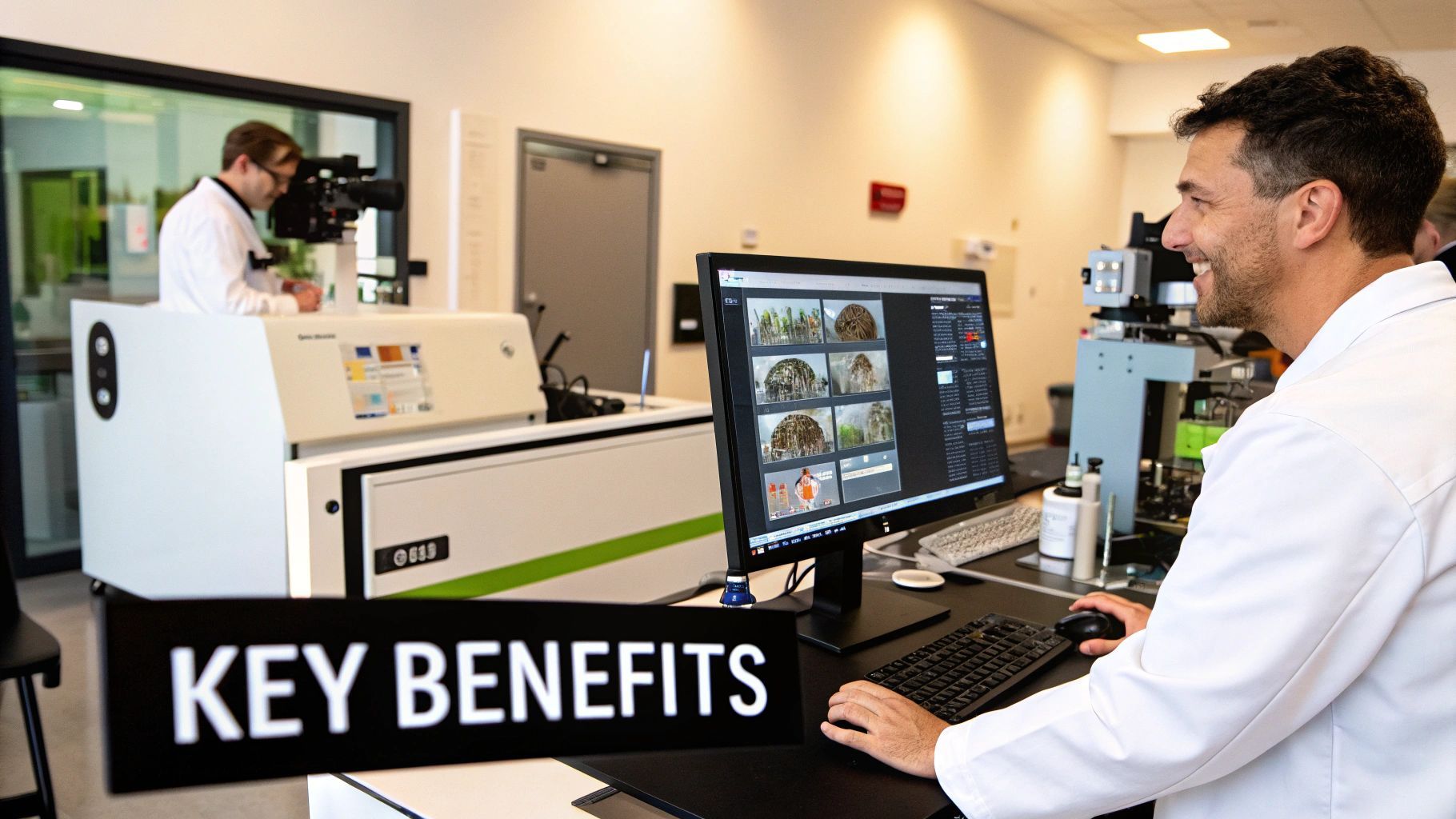
This is where the rubber really hits the road. An ai image to video generator isn't just a cool new gadget for tech enthusiasts; it's a serious workhorse that's already shaking things up across different industries. We're talking about a fundamental shift in how people create, market, and even teach. Breathing life into a still picture turns out to be a massive game-changer for getting things done and grabbing people's attention.
For anyone in marketing, the appeal is instant. You’ve got a gorgeous new product line with dozens of professional photos. Instead of another static carousel on social media, you can now spin each one into a snappy, eye-catching video ad in just a few minutes. Imagine a subtle pan across a stunning real estate photo to give a real sense of the space, or a slow zoom on a product to guide a customer's gaze. It just works.
This move from static to dynamic isn't just a fleeting trend—it's smart strategy. To really get a handle on how big this is, it helps to understand the broader opportunities and challenges in AI digital marketing. You start to see how these animation tools are one piece of a much larger puzzle in connecting with customers through AI.
The fun really starts when you look beyond marketing departments. The creative floodgates have been thrown wide open, paving new ways for expression in fields that used to be held back by tight budgets or a lack of technical chops.
Educators: Think about bringing history lessons to life. A teacher could animate a grainy black-and-white photo of a 1920s city street, suddenly making the era feel tangible and exciting for students. Artists & Photographers: A portrait photographer can add a soft, subtle breath or a slow blink to their subject, injecting a still image with a shocking amount of soul and emotion. For digital artists, it's a whole new canvas to play on. Real Estate Agents: Forget flat photos. Agents can now stitch together captivating virtual tours from their listing pictures. A gentle sweep across a living room or a smooth zoom-out from a beautiful garden gives buyers a much better feel for a home before they even step inside. Small Businesses: A local bakery can make a picture of a fresh croissant look irresistibly steamy on Instagram. A freelance designer can animate their static logos for their portfolio, adding that extra bit of professional flair.
The real magic here is that video creation has been handed to the masses. What used to demand expensive software and hours of tedious work can now be done in a snap, turning practically anyone into a video creator.
This newfound accessibility is lighting a fire under the market. Industry forecasts show the AI video generator market, valued at around USD 800 million in 2025, is on track to explode to nearly USD 5 billion by 2035. That's a staggering compound annual growth rate of about 20%, fueled by an insatiable demand for tools that can do everything from these simple animations to far more complex video projects.
Tools like SendFame are right at the heart of this movement, offering dead-simple platforms where all these ideas become reality with just a few clicks. The entire point is to demolish the technical hurdles. You don't need to know what keyframes or motion paths are; you just need a great picture and a spark of an idea.
For example, animating a company logo was once a job you’d hire a motion graphics specialist for. Now, a marketing manager can upload a PNG, apply a slick effect, and have it ready for a presentation or the company website in minutes. In the same way, a content creator can take a simple character drawing and make it a subtly breathing avatar for their YouTube channel. If you're ready to jump in, our guide on the best AI image to video generator is a fantastic place to start looking for the perfect tool.
When it comes down to it, this tech closes the gap between what you can imagine and what you can actually create. It’s a fast, cheap, and surprisingly simple way to make your content pop, proving that sometimes, a little bit of motion makes all the difference.
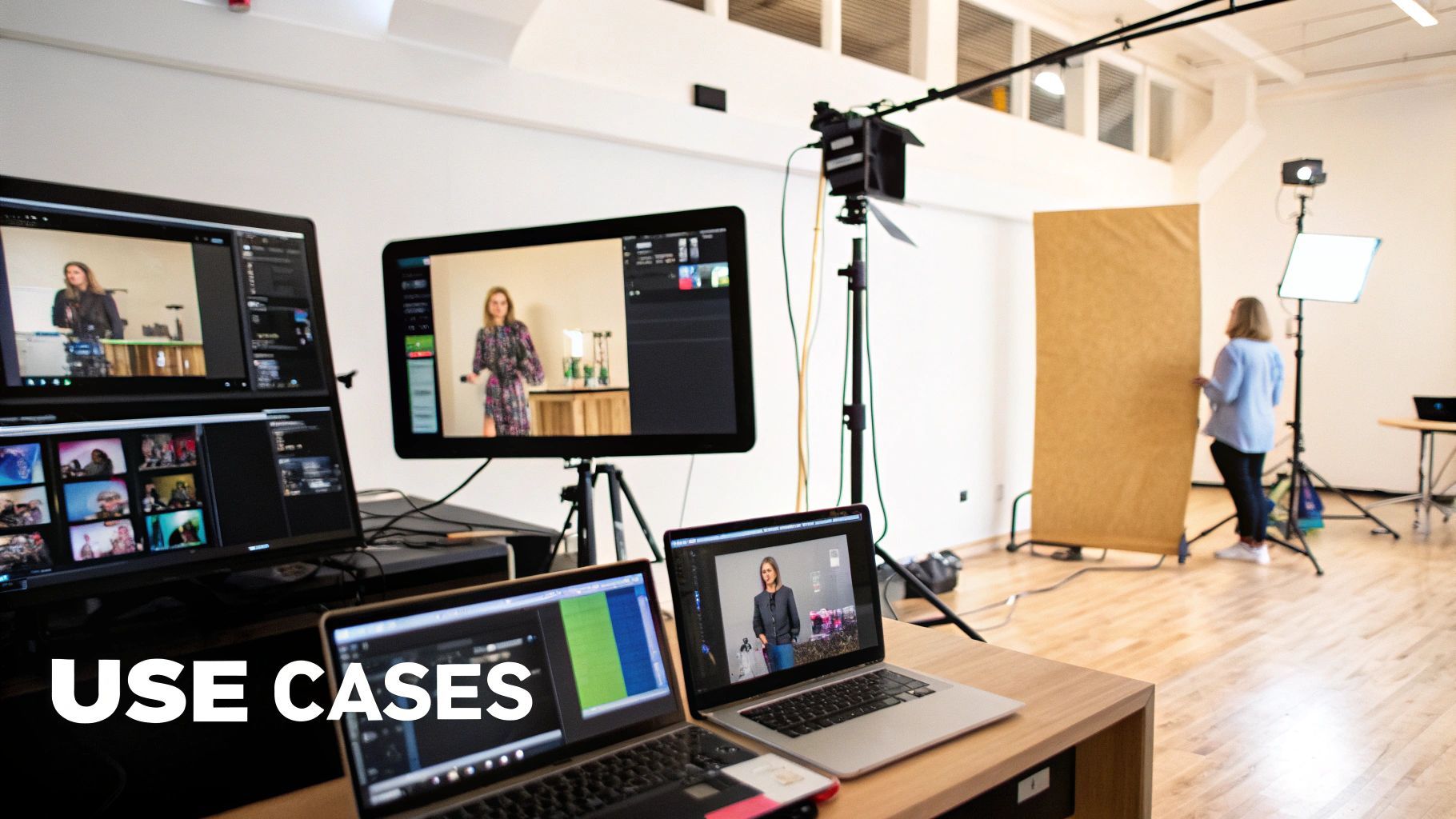
Diving into AI animation is a blast, but it’s easy to get overwhelmed by the sheer number of tools out there. Let’s be real: not every AI image to video generator is built the same. Some are like a simple point-and-shoot camera—great for quick snaps. Others are more like a professional DSLR with a full kit of lenses, ready for a masterpiece.
Finding your perfect match isn't about finding the tool with the most buttons. It's about matching its power to what you want to create. Are you just trying to make a fun, snappy clip for your social media story, or are you crafting a polished marketing video that needs to look just right? Figure that out first, and you're already halfway there.
So, what separates the basic tools from the pro-level ones? Control. It's the secret sauce. The best tools give you a director's chair, letting you orchestrate the movement and feel of your video instead of just hitting "go" and hoping for the best.
Think like a filmmaker for a second. They don't just plop a camera down. They use pans, tilts, and zooms to pull the audience into the story. A good AI tool hands you those same controls.
Pan: This is your side-to-side camera movement. It's brilliant for taking a wide landscape photo and sweeping across it, giving it a sense of epic scale. Tilt: This is the up-and-down motion. Imagine tilting your camera up the side of a towering skyscraper to make it feel even more massive. Zoom: This one’s a classic. A slow zoom-in on a face can create instant intimacy, while a quick zoom-out can reveal a surprising twist in the scene.
But it’s not just about the camera moves. The top-tier generators also offer style presets. You can dial in a "cinematic" look for smooth, dramatic motion or maybe a "whimsical" style for something more playful and bouncy. It's a fantastic shortcut to setting the perfect mood.
The AI animation world pretty much splits into two camps: the one-click wonders and the platforms built for deep creative dives.
The simple apps are awesome for speed. You upload an image, tap an effect, and boom—you're done. They’re perfect for casual users or anyone who needs a quick animation without any fuss.
But for creators who need to get things just so, those simple apps can feel like a straitjacket. That's where more advanced platforms shine. A great example is the AI image to video generator from SendFame, which hits that sweet spot between ease of use and creative freedom. You get powerful, intuitive controls without needing an engineering degree to figure them out.
The best tool isn't the one with the most features. It's the one that gives you the right amount of control for the job, without getting in your way.
This is a really important distinction. That hilarious meme you're making? A simple tool is probably all you need. That slick brand video for a new product launch? You'll want the precision that a more robust platform offers.
To make it crystal clear, let's break down how these different types of tools stack up.
Here's a look at how different tools serve different needs, from quick and easy to fully professional.
| Feature | Simple One-Click Tools | Advanced Platforms (like SendFame) | Professional Animation Software |
|---|---|---|---|
| Creative Control | Very low, usually just pre-set effects. | High, with options for motion path, speed, and style. | Total, but with a massive learning curve. |
| Ease of Use | Extremely high. Absolutely perfect for beginners. | Moderate. A little learning goes a long way. | Very low. Requires professional training. |
| Output Quality | Varies, but often standard HD. | High, typically offering full HD or even 4K resolution. | Professional grade, limited only by skill. |
| Use Case | Quick social media posts, memes, personal fun. | Marketing videos, artistic projects, detailed animations. | Feature films, high-end commercials, complex VFX. |
Ultimately, picking the right AI image to video generator is a personal choice. If you're just dipping your toes in the water, a simple app is a fantastic place to start. But if you're serious about creating truly unique, high-quality animated content, you'll want to graduate to a platform with deeper controls. It’s that extra level of customization that will let your creative vision really shine.
Alright, enough with the theory. It's time to roll up our sleeves and actually create something. This is the fun part—where we go from "how it works" to "look what I made!" And honestly, turning a still photo into a moving video with an ai image to video generator like SendFame is way easier—and more fun—than you might think.
We're going to walk through the whole shebang, step-by-step. From choosing the right photo to adding those final, polished touches. By the time we're done, you'll be turning your favorite pics into thumb-stopping video clips like a pro.
Let's jump in.
Here’s the deal: your final video is only ever as good as the image you start with. It's like cooking—you can't expect a Michelin-star meal from last week's leftovers. While you can animate any photo, the right kind of image will give you truly jaw-dropping results.
So, what makes a great source image?
A Clear Star of the Show: The AI needs to know what to focus on. A photo with a single, obvious subject—a person, a cool car, a striking building—will always animate more cleanly than a super busy, cluttered scene. A Sense of Depth: Pictures with a clear foreground, middle, and background give the AI so much more to play with. Think of a landscape shot with a lake up close and mountains way off in the distance. That's a perfect canvas for creating believable movement. High-Resolution is Key: Always, always, always start with the sharpest, highest-quality image you have. A fuzzy, pixelated photo will only lead to a fuzzy, pixelated video.
Got your image picked out? Great. To follow along and start creating, head over to the SendFame platform to access their awesome suite of creative tools.
The best part about a tool like SendFame is that it doesn't feel like you need an engineering degree to use it. The interface is clean and intuitive, so you won't get lost in a sea of confusing menus. Once you upload your image, you’ll land in a simple workspace, ready to bring your photo to life.
This is the SendFame AI tools dashboard, where you can easily spot the image-to-video feature.
See? Everything is laid out clearly, so you can find what you need and get straight to creating.
Next up, you get to play director. It's time to choose your motion. Most generators give you a bunch of options that feel like real camera movements.
The secret isn't just making the picture move; it's about making it move with purpose. A slow, gentle pan can create a feeling of wonder, while a sudden zoom can inject a shot of pure energy.
You’ll usually see controls like these:
Pan (Left, Right, Up, Down): This is your classic sweeping motion. It’s perfect for showing off the full scale of a gorgeous landscape. Zoom (In, Out): Use this to pull your viewer’s focus toward a key detail or to pull back and reveal the bigger picture. Rotate (Clockwise, Counter-Clockwise): A little bit of rotation can add a stylish, dynamic feel that makes the whole scene pop.
Once you've picked a basic movement, the real fun begins. Now you get to tweak the speed, the intensity, and the overall vibe of the animation to match what you see in your head. The big choice here is between subtle and dynamic motion.
Subtle Motion: Think slow, almost unnoticeable movements. This is perfect for portraits where you just want to add a flicker of life—like the hint of breathing or a soft, slow blink. It's classy and mesmerizing. Dynamic Motion: This is the big, bold stuff. A fast zoom or a dramatic pan creates a high-impact, attention-grabbing effect. It's fantastic for exciting marketing clips or social media stories.
Play around with the speed settings. A slower animation often feels more cinematic and high-end, while a faster pace can be more playful and punchy. It all comes down to the mood you're trying to create.
Want to learn a seriously cool trick? Make a cinemagraph. This is a stunning hybrid where most of your photo stays completely frozen, but one or two small elements move in an endless, seamless loop. Picture a still photo of a coffee cup, but with steam constantly rising. Or a quiet forest scene where a waterfall flows forever.
These are absolute gold on social media. They catch the eye because they look like living photographs. To make one, find a picture with an element that has a natural, repeatable motion—like smoke, water, fire, or twinkling lights. Apply a subtle motion effect to just that part and set your video to loop. The result is a piece of content that feels like pure magic.
Jumping into the world of an AI image to video generator feels a bit like stepping into the future. It's exciting, a little mind-bending, and naturally, it sparks a ton of questions. How does a computer actually make a photo move? What’s the secret sauce? Are there limits? And, the big one: how can I make it work for me?
Let's pull back the curtain. We've rounded up the most common questions we hear and are here to give you straight, no-nonsense answers. Our goal is to take the mystery out of the magic so you can go from just being curious to creating with confidence.
This is the million-dollar question, and it's less about digital voodoo and more about some seriously sophisticated "educated guessing."
Imagine an AI that has binge-watched millions of hours of video footage. It’s seen how water ripples, how clouds drift across the sky, and how a person's head turns. It has absorbed the basic physics of our world and learned the language of motion.
When you give it a static picture, it doesn't just see a flat collection of pixels. It analyzes the scene, identifies objects—a tree, a lake, a person's face—and then digs into its massive mental library of movement. It then makes a highly educated prediction about what motion would look natural for that scene. It’s not just stretching the image; it’s generating brand new pixels to create a sequence of frames, building believable motion from scratch. So when you see a smooth camera pan, the AI is literally inventing the parts of the scene that were hidden from view.
You can toss pretty much any image at an AI, but let's be real—some will produce jaw-dropping results while others will just look... weird. To get the good stuff, you need to give the AI a quality canvas to paint on.
Here's a cheat sheet for images that almost always work wonders:
Landscapes with Natural Elements: Got photos with big skies, water, or lots of trees? Perfect. AI is a natural at making clouds drift, water shimmer, and leaves rustle in a non-existent breeze. Portraits with a Clear Subject: A sharp, well-lit portrait is prime real estate for subtle animation. Think a slow blink, a gentle head turn, or the illusion of breathing. It adds a shocking amount of life and emotion. Clean Product Shots: Have a product on a simple background? These are gold for creating dynamic ads. You can add zooms and pans to highlight key features or create an eye-catching reveal that stops the scroll. Architectural Photos: Images of buildings or interiors with strong lines and a good sense of depth are fantastic. Animating them with smooth camera moves can create a surprisingly immersive virtual tour.
The golden rule? Use high-resolution images with a clear subject and a sense of depth. A cluttered, flat, or low-contrast photo can confuse the AI, often leading to wonky or unconvincing animations.
You bet, and this is where you go from a user to a creator. The amount of control you get, however, varies wildly between different tools. This is probably the biggest thing to consider when picking your platform.
Some of the simple, one-click mobile apps might just give you a few preset options like "Zoom In" or "Pan Left." They’re fun for a quick social post but can feel incredibly restrictive if you have a specific vision.
This is where more advanced platforms like SendFame really shine. They put the steering wheel back in your hands, often letting you:
Draw Custom Motion Paths: You can literally tell the "camera" exactly where to go. Tweak Speed and Intensity: Want a slow, dreamy drift or a fast, energetic zoom? You get to decide. Mask Static Areas: This is the secret weapon for making stunning cinemagraphs. You can tell the AI to keep a person perfectly still while the waterfall roars behind them.
This level of control is what turns an AI image to video generator from a fun little toy into a serious creative tool. For a deeper look at what separates the good from the great, check out our guide on the best AI video generator to see how different options stack up.
Okay, this one is huge, especially if you’re making content for your business. The answer has a few layers, but it boils down to two things: the image you started with and the fine print in the tool's terms of service.
As a rule of thumb, if you use an image that you own the copyright to (you snapped the photo yourself or bought a proper license), then you also own the copyright to the video you create from it. The AI-generated video is considered a "derivative work," and the rights flow from the original piece.
But—and this is a big but—you always need to read the terms of service for the AI tool you're using. Some platforms might try to claim some rights to content generated on their service. To keep things clean and simple, especially for professional work, the best practice is always to use your own original, high-quality images. That way, you know you have full ownership and can use your awesome new video without any legal headaches down the road.
Ready to stop wondering and start creating? With SendFame, you can turn your best photos into dynamic, attention-grabbing videos in just a few clicks. Whether you're making ads, social media content, or just bringing a favorite memory to life, our intuitive tools give you the creative control you need. Try SendFame's AI video tools today!
Create Epic
SendFame